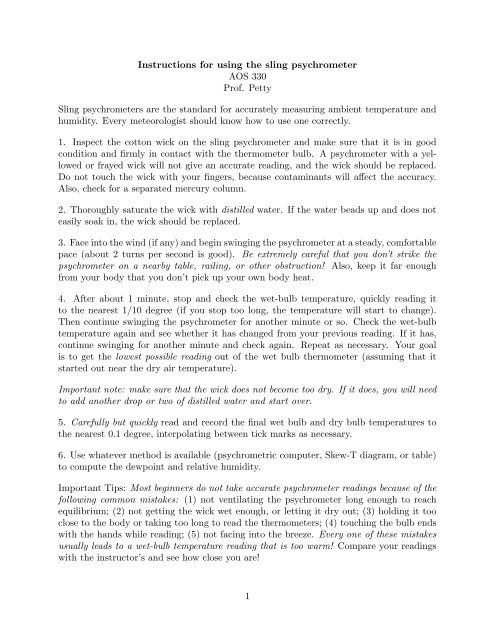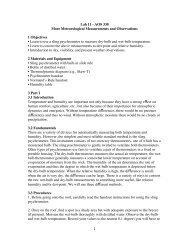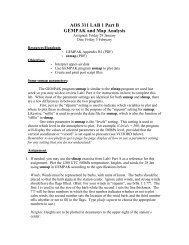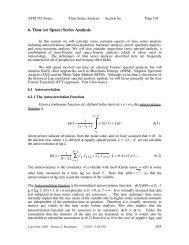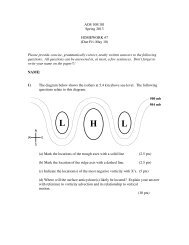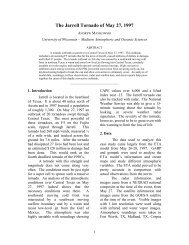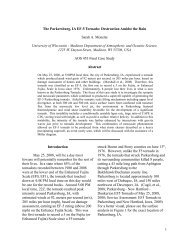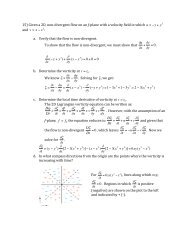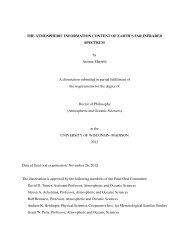Using a sling psychrometer
Using a sling psychrometer
Using a sling psychrometer
Create successful ePaper yourself
Turn your PDF publications into a flip-book with our unique Google optimized e-Paper software.
Instructions for using the <strong>sling</strong> <strong>psychrometer</strong><br />
AOS 330<br />
Prof. Petty<br />
Sling <strong>psychrometer</strong>s are the standard for accurately measuring ambient temperature and<br />
humidity. Every meteorologist should know how to use one correctly.<br />
1. Inspect the cotton wick on the <strong>sling</strong> <strong>psychrometer</strong> and make sure that it is in good<br />
condition and firmly in contact with the thermometer bulb. A <strong>psychrometer</strong> with a yellowed<br />
or frayed wick will not give an accurate reading, and the wick should be replaced.<br />
Do not touch the wick with your fingers, because contaminants will affect the accuracy.<br />
Also, check for a separated mercury column.<br />
2. Thoroughly saturate the wick with distilled water. If the water beads up and does not<br />
easily soak in, the wick should be replaced.<br />
3. Face into the wind (if any) and begin swinging the <strong>psychrometer</strong> at a steady, comfortable<br />
pace (about 2 turns per second is good). Be extremely careful that you don’t strike the<br />
<strong>psychrometer</strong> on a nearby table, railing, or other obstruction! Also, keep it far enough<br />
from your body that you don’t pick up your own body heat.<br />
4. After about 1 minute, stop and check the wet-bulb temperature, quickly reading it<br />
to the nearest 1/10 degree (if you stop too long, the temperature will start to change).<br />
Then continue swinging the <strong>psychrometer</strong> for another minute or so. Check the wet-bulb<br />
temperature again and see whether it has changed from your previous reading. If it has,<br />
continue swinging for another minute and check again. Repeat as necessary. Your goal<br />
is to get the lowest possible reading out of the wet bulb thermometer (assuming that it<br />
started out near the dry air temperature).<br />
Important note: make sure that the wick does not become too dry. If it does, you will need<br />
to add another drop or two of distilled water and start over.<br />
5. Carefully but quickly read and record the final wet bulb and dry bulb temperatures to<br />
the nearest 0.1 degree, interpolating between tick marks as necessary.<br />
6. Use whatever method is available (psychrometric computer, Skew-T diagram, or table)<br />
to compute the dewpoint and relative humidity.<br />
Important Tips: Most beginners do not take accurate <strong>psychrometer</strong> readings because of the<br />
following common mistakes: (1) not ventilating the <strong>psychrometer</strong> long enough to reach<br />
equilibrium; (2) not getting the wick wet enough, or letting it dry out; (3) holding it too<br />
close to the body or taking too long to read the thermometers; (4) touching the bulb ends<br />
with the hands while reading; (5) not facing into the breeze. Every one of these mistakes<br />
usually leads to a wet-bulb temperature reading that is too warm! Compare your readings<br />
with the instructor’s and see how close you are!<br />
1
Instructions for using the psychrometric computer<br />
If you are using the psychrometric computer (circular slide rule) to compute dewpoint and<br />
temperature from your dry-bulb and wet-bulb readings, follow this procedure.<br />
1. If your readings are in degrees Celsius, you will have to convert them to Fahrenheit for<br />
this calculation. Use the formula<br />
[ ◦ F ] = 32 + (9/5 × [ ◦ C])<br />
2. Subtract the wet-bulb temperature T w from the dry-bulb temperature T to get the<br />
wet-bulb depression D in degrees Fahrenheit.<br />
3. Find the zero index on the outer ring of the movable disk and point it at the wet-bulb<br />
temperature on the outer-most scale.<br />
4. Look clockwise from the zero until you find the wet-bulb depression D. Read the<br />
dewpoint temperature T d from the outermost scale.<br />
5. To compute the relative humidity, find 100% on the innermost scale and point it at the<br />
dry-bulb temperature T . Then follow the temperature scale counterclockwise until you<br />
find the dewpoint T d . Read the corresponding relative humidity on the innermost scale.<br />
6. If required, convert your dewpoint temperature back to Celsius using the following<br />
formula:<br />
[ ◦ C] = 5/9 × ([ ◦ F ] − 32)<br />
2


